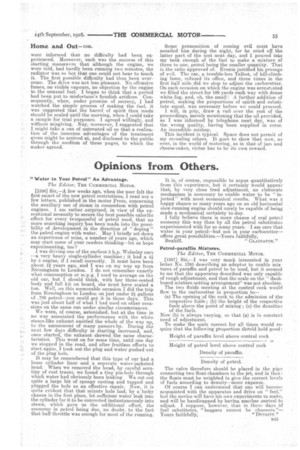Opinions from Others.
Page 15

If you've noticed an error in this article please click here to report it so we can fix it.
"Water In Your. Petrol" An Advantage.
The Editor, THE COMMERCIAL MOTOR.
(1386] Sir,—A few weeks ago, when the user felt the first smart of the new petrol restrictions, I read not a few letters, published in the motor Press, concerning the auxiliary use of steam in connection with petrol engines. I am rather surprised, in view of the exceptional necessity to secure the best possible calorific effect for every teaspoonful of petrol used, that no in ore searching inquiry has been made into the possibility of development in the direction of " doping " the petrol engine with water. May I briefly set down an experience of mine, a number of years ago, which may start some of your readers thinking—let us hope experimenting, too was driving one of the earliest 5 h.p. WolseIey cars --a very heavy single-cylinder machine ; it had a 41 by 5 engine, if I recall correctly. It must have been about 12,years ago' and I was on my way up from Birmingham to London. I do not remember exactly what consumption or m.p.g. I used to average on the old car, but I should think, with her three-seated body and full kit on board, she must have scaled a ton. Well, on this memorable occasion I did the trip from Birmingham to London on just under 21 gallons of .700 petrol—you could got it in those days. This was just about half of what I had used on other occasions on the same run under similar, circumstances.
We were, of course, astonished, but at the time in no way associated the performance with the white steam-like exhaust emitted the whole of the way up, to the amusement of many passers-by. During the next few days difficulty in starting increased, and, once started, the exhaust showed the same characteristic. This went on for some time, until one day we stopped in the road, and after fruitless efforts to start again, I took out the plug and water gushed out of the plug hole.
It may be remembered that this type of car had a loose cylinder liner and a separate -water-jacketed head. When we removed the head, by careful scrutiny of rust traces, we found a tiny pin-hole through which water had obviously been leaking We cut out quite a large bit of spongy casting and tapped and plugged the hole as an effective repair. Now, it is quite evident that that minute hole had, by a lucky chance in the first place, let sufficient water leak into the cylinder for it to be converted instantaneously into steam, which gave us the additional effort, the economy in petrol being due, no doubt, to the fact that half throttle was enough for most of the running.
It is, of course, impossible to argue quantitatively from this experience, but it certainly would appear that; by very close feed adjustment, no elaborate mechanism is necessary to enable water to be "injected" with most economical results. What was a happy chance so many years ago on an old horizontal slow-running engine should surely be capable of being made a mechanical certainty to-day.
I fully believe there is more chance of real petrol economy this way than by all the petrol substitutes experimented with for so many years. I am sure that water in your petrol—but not in your carburetter— offers great possibilities.—Yours faithfully, Bexhill. "GLADIATOR."
Petrol-paraffin Mixtures.
The Editor, THE COMMERCIAL MOTOR.
(1387] Sir,—I was very much interested in your letter No. 1383 describing an adaptor to enable mixtures of paraffin and petrol to be used, but it seemed to me that the apparatus described was only capable of rough adjustment, and that the scale on the "dashboard mixture, setting arrangement" was not absolute.
The two fluids meeting at the control cock would flow to the carburetter in proportion to—
(a) The opening of the cock to the admission of the. respective fuels; (13) the height of the respective fuels above the point of mixing ; (c) the densities of the fuels.
Now (b) is always varying, so that (a) is in constant need of adjustment. To make the scale correct for all times would require that the following proportion' iheruld hold good : Height of paraffin level above control cock Height of petrol level above control cock Density of paraffin.
Density of petrol.
The valve therefore should be placed in the pip!, connecting two float chambers to the jet, and in thes1 the floats must be weighted to give the correct levels of fuels according to density—more expense.
Of course I can understand that one will become acquainted with the apparatus and drive on " feel," but the novice will have his own experiments to make, and will be handicapped by having another eontrol to adjust I suppose, however, that in these days of fuel substitutes, "beggars cannot be choosers."- Yours faithfully, " DRiCSITY "






















